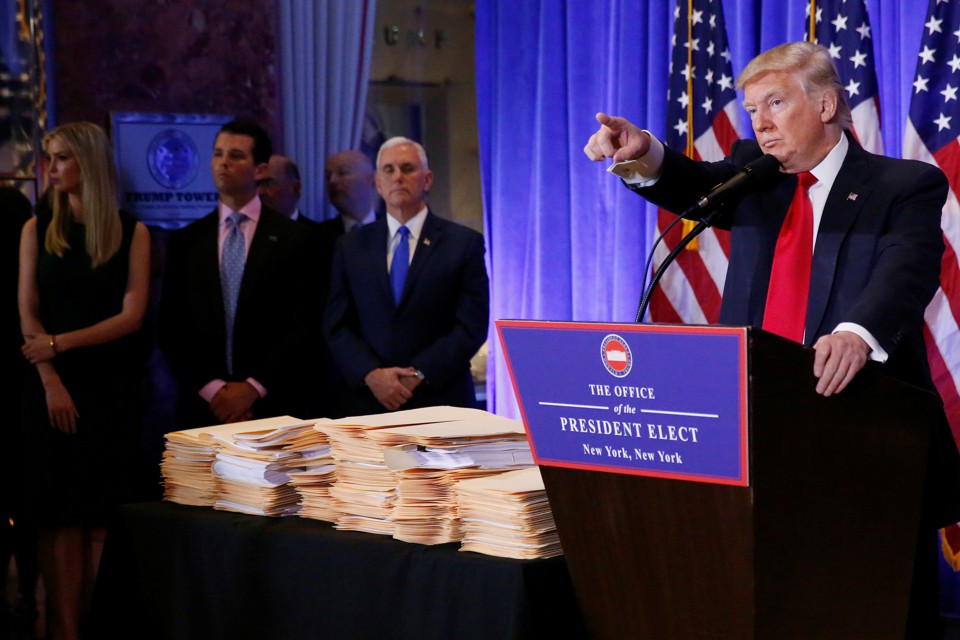The Great Instigator
Unlike past presidents-elect, Donald Trump hasn’t expanded his support since the election. His belligerent attitude toward his critics may be one reason why.

This combustible approach has touched a chord with his base of primarily non-college-educated and non-urban white voters who have felt eclipsed both economically and culturally and slighted by the nation’s leadership. But he will arrive at his inaugural Friday facing more resistance in public opinion than any newly elected president in the history of polling, and with lingering clouds over his legitimacy—symbolized by the surprisingly widespread House Democratic boycott of the ceremony. Trump’s agenda is polarizing enough, but the intensity of that opposition appears rooted even more in his relentless belligerence toward any critical voice or institution.
Trump’s tumultuous transition has unfolded like a Hong Kong kung fu movie, with each fight transitioning seamlessly into the next. As a candidate, he responded to almost any criticism by denigrating the source. As president-elect, he’s continued the pattern: Through tweets, press conferences, and interviews, Trump has blasted insults at targets from Representative John Lewis to Meryl Streep to German Chancellor Angela Merkel. If Ronald Reagan was the great communicator, Trump is becoming the great instigator.
More so than it initially appeared, there may be method to this madness: The sheer profusion of Trump controversies makes it difficult for the press, the partisan opposition, or the public to focus very long on one before the next supplants it. And for many of Trump’s core supporters, the constant conflict proves he will take the fight to all the institutions they believe have failed them.
Indeed, amid all the swirling currents, the clearest message of Trump’s transition is that he has narrowed his support since Election Day, rather than expanding it as almost all of his predecessors did. In Gallup polling dating back through 1953, no new president has ever taken office with a positive job-approval rating from less than 51 percent of adults (Ronald Reagan in 1981 and George H.W. Bush in 1989) or a disapproval rating higher than 25 percent (George W. Bush in 2001). All indications are that Trump will start in a much weaker position.
Results from this week’s flurry of polls capture an unprecedented level of unease about a new president. In an ABC/Washington Post survey, just 40 percent approved of Trump’s handling of the transition, and just 40 percent said they had a favorable personal impression of him. Only 44 percent said they mostly trusted Trump “to make the right decisions for the country’s future.” Other public surveys have returned very similar findings.
Polls during the transition offer some good news for Trump. On dealing with jobs and terrorism, the public’s expectations are more optimistic than these overall assessments. And he retains solid support from whites without a college degree (though even among those voters his transition approval is lagging his Election Day vote share).
These numbers may not dissuade congressional Republicans from initially locking arms with him to pass an agenda where their interests overlap—particularly in repealing the Affordable Care Act, cutting taxes, and retrenching federal regulation. But if Trump continues to provoke such public resistance, it will inexorably make it tougher for him to manage Capitol Hill, because nothing has greater impact on modern congressional elections than the president’s standing.
In the 2010 Republican wave, Democrats won the Senate seats in nine of the 10 states with exit polls where Obama’s approval rating stood at 48 percent or above—but lost 13 of the 15 where he ranked at 47 percent or below. In the 2006 Democratic surge, Senate Republicans lost 19 of the 20 races in states where George W. Bush’s approval rating stood at 45 percent or below.
Presidents often enjoy their broadest support when they take office. Yet Trump could begin with a job-approval rating comparable to Bush’s weak standing in fall 2006, and to Obama’s lowest level ever. “We know ... the state of the president has enormous impact on the party in the midterm election,” said Dan Pfeiffer, a former White House senior strategist for President Obama. “And Trump is going to start at a number that would cause most people to hit the panic button.”
Trump shows no indication of reaching for any button except the one on his smartphone that says “tweet.” But his tenuous poll standing underscores the gamble he represents for Republicans. With a successful term, Trump and White House consigliere Stephen Bannon might fulfill their hopes of building a “worker’s party” across racial lines. But Trump’s truculent transition suggests he could as easily compound the GOP’s challenges with growing groups like Millennials, minorities, and college-educated white women. Stormy seas are the only waters Trump knows—and Republicans have now bound themselves to his course like a sailor lashed to the mast.
No comments:
Post a Comment